Today we wake early, stepping into the soft, coastal air of Lisbon as the city lay quiet and half-asleep. Walking through the still lanes of Baixa, a few mists linger around, and the Tagus River shimmers softly in the distance. The peace of the morning fills us with calm, every street corner whispers a new glimpse of Castelo de São Jorge, framed by the rising sun.

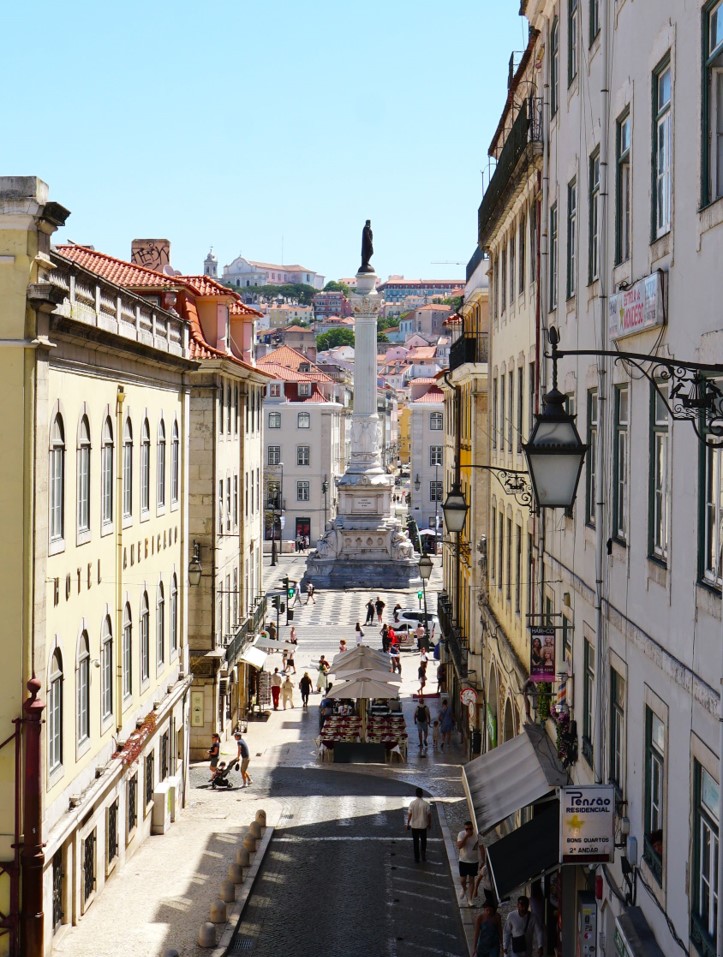
For breakfast, we found a cozy spot overlooking Rossio Square. Here we enjoyed our classic favorites: crispy bacon, fluffy scrambled eggs, and a juicy omelet, alongside a tosta mista— a Portuguese sandwich with a golden, crispy crust and gooey melted cheese and savory ham inside – simple, yet a filling fuel-up for our day ahead.


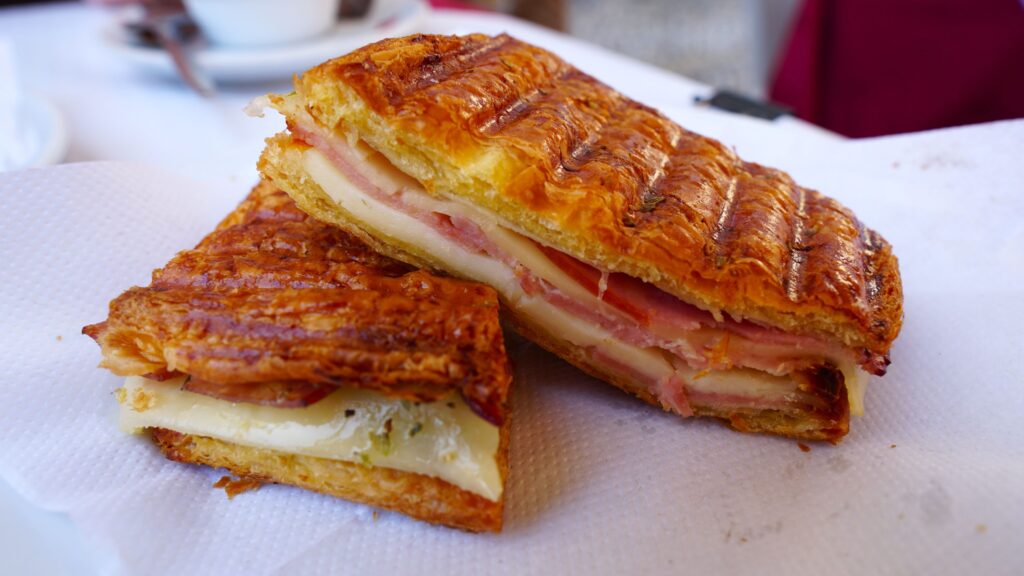
Our destination: Parque das Nações, a stunning modern marvel in Lisbon. Once the site of Expo 98, a World Fair focused on “The Oceans, a Heritage for the Future,” this area is an architectural spectacle.

The whole space feels expansive and futuristic, with open plazas and unique art installations. One of its icons is the striking Homem-Sol (Man-Sun), a powerful, dark, spiky metal sculpture by Jorge Vieira. With its abstract, human-like form and jagged edges, the statue embodies the fusion of human and cosmic elements, symbolizing exploration and discovery.
For the best view of this iconic piece and the surrounding square, head to the upper floors of the Vasco da Gama Shopping Mall, where the food court opens to a terrace. From there, you’ll have an elevated perspective of both the sculpture and the open square below.
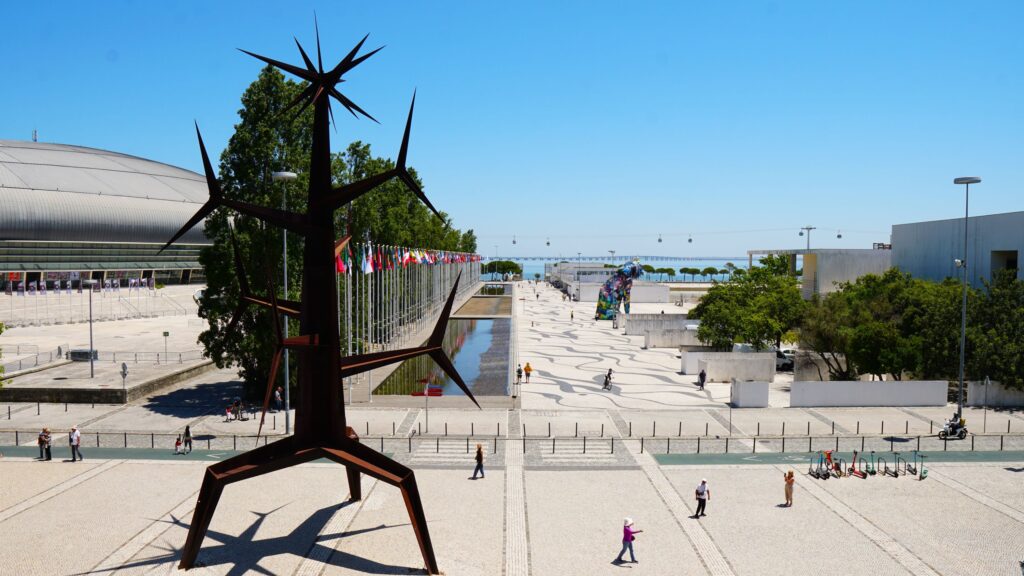
Nearby, you’ll find another unusual sight—Lince Ibérico, a large metal sculpture resembling a massive cat, crafted from colorful patchwork pieces. This piece honors the Iberian lynx, one of the region’s most endangered species.

Flanking the square are the twin São Gabriel and São Rafael towers, two buildings with pointed tops that rise side-by-side like the masts of ships, a nod to Portugal’s maritime past. In the same space, an iron sculpture of two figures mid-dance brings a sense of movement to the spacious calm of this urban landscape.


We take a stroll along the waterfront, where the path is lined with trees blooming with red flowers. The path follows the cable car lines, and we recommend walking to the end of the line before hopping on a one-way ticket for the scenic ride back.
Near the cable car station, you’ll get an up-close view of the Vasco da Gama Tower. This 145-meter tall structure is designed to evoke the spirit of exploration, with its sail-like form and sweeping views of the Tagus River.

Standing tall against the skyline, it’s a symbol of Lisbon’s enduring connection to the sea and its ever-forward spirit.
Riding the cable car, you’ll be treated to panoramic views: on one side, the sparkling coastline, and on the other, the modern architecture of Parque das Nações. From above, you’ll see the iconic Vasco da Gama Bridge, stretching gracefully across the river, its span almost as endless as the crystal-clear, calm waters below, mirroring the cloudless blue sky. It’s an ideal way to take in the full scope of the Expo 98 site.


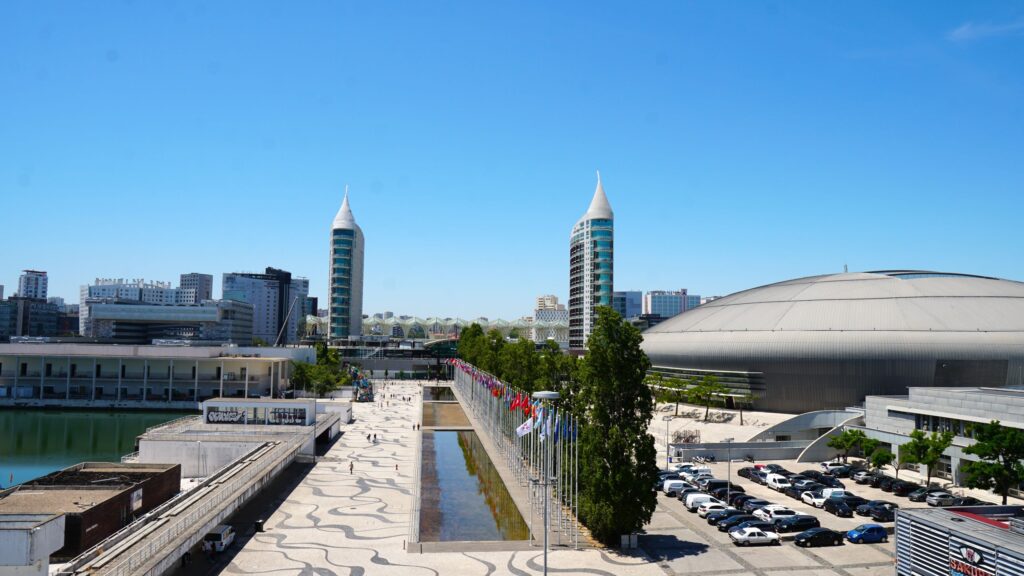
After taking the cable car to the other side, you’ll find yourself right at the entrance to the Oceanário de Lisboa, Europe’s largest indoor aquarium. With a massive central tank and an incredible array of marine life, it’s a must-see destination that takes about 2-3 hours to fully explore. You can get tickets right at the entrance. The aquarium is open daily from 10 AM to 8 PM.

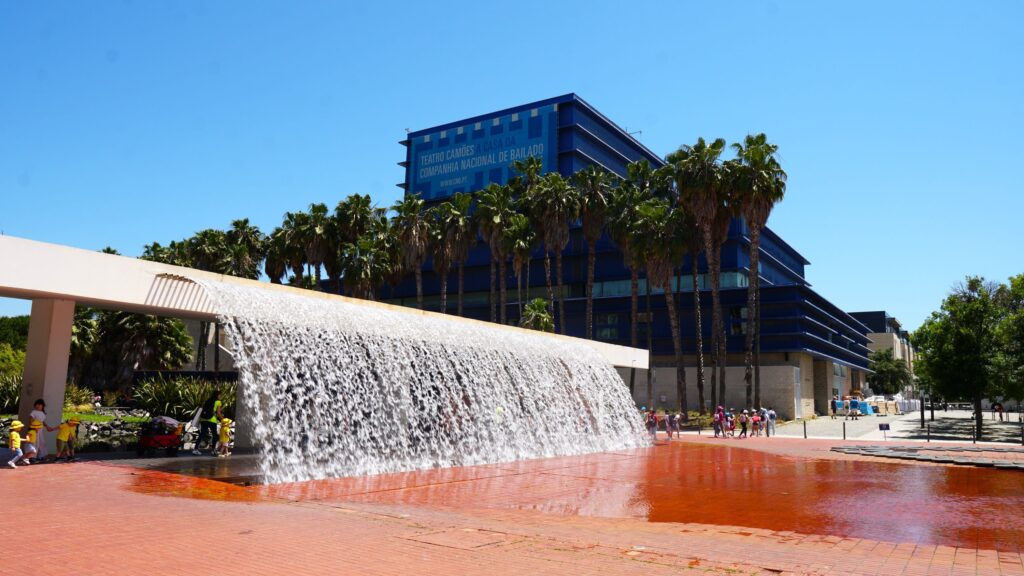
One of the most famous residents of the Oceanário is the sea otter, a rare species rescued as part of a conservation effort. This otter is quite endearing, especially for its cute behavior – constantly grooming its fur – sometimes up to 1,000 times a day! For otters, this grooming ritual is essential for their survival, as they rely on perfectly conditioned fur to trap air and keep warm in cold waters.
You’ll see all sorts of marine life in the aquarium – such as a mighty shark gliding close, its rows of pointed teeth intimidating yet fascinating, especially to the children, squealing in slight terror.
Then came the flattened stingray, its grills “peering up” from the bottom, and an odd, blue triggerfish, its prominent lower lip giving it a quirky pout.


Jellyfish float by—one species with long, ghostly tentacles, another like tiny, glowing blue mushrooms with dotted caps that glimmer in the dim light.


We spotted leafy sea dragons (or weedy sea dragons), their golden bodies with leaf-like appendages blending beautifully with underwater plants.

And, of course, you can say hello to Nemo and his colorful companions in the coral reef tanks

The giant sunfish, or Mola mola, at Lisbon’s Oceanário is an oceanic oddity, just for its rarity and sheer size. It’s known as the largest bony fish in the world. The adult sunfish can grow over 3 meters (about 10 feet) long and weigh more than two tons.
It takes our breath away as it swims close, locking us in a deep, thoughtful gaze – a quiet sense of connection—as if, in that moment, we’re sharing a silent understanding with one of the ocean’s oldest mysteries.
If you get hungry, the Oceanário has a canteen with some great vegetarian options. We tried baked sweet potato chips—crispy, sweet, with a hint of smokiness—and a tangy tomato tartar with savory toasted bread croutons. They make for a perfect light bite while you take in the sights.
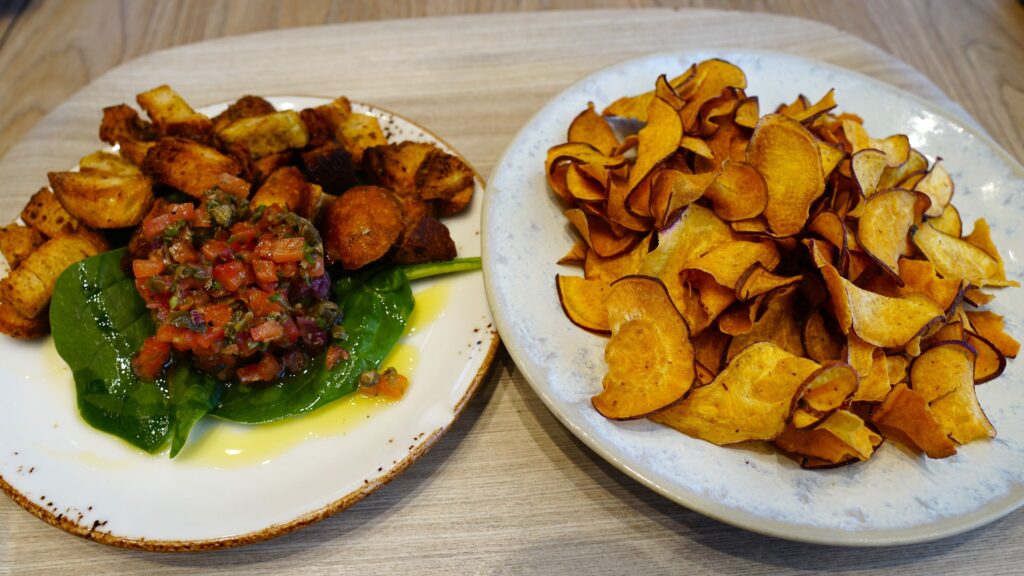
More tips for your visit:
- Oceanário de Lisboa: Europe’s largest indoor aquarium is a must-see. Plan for 2-3 hours to fully enjoy it. Tickets cost around €25 for adults, and you can buy them at the entrance (more info).
- Events at Expo Facilities: The Altice Arena and FIL (Lisbon’s International Fair) in this area are well-known expo facilities that regularly host concerts, conventions, and festivals. Check their schedules online (more info here and here)—it can be a fantastic way to experience Lisbon’s cultural scene.
- Dining Options: While Parque das Nações has a food court in Centro Vasco da Gama mall, you might find the dining options in this area limited. For a meal with more local flavor, it’s better to head back to the center.
- Getting There: From central Lisbon, take the red metro line directly to Oriente Station, a quick 20-25 minute ride. Once there, everything is within walking distance, including the aquarium, expo centers, and scenic riverside views.
After a day at Parque das Nações, we head back to the lively Bairro Alto, where we discovered Duque, a cozy, much-loved local spot known for its warm atmosphere and thoughtful, authentic Portuguese cuisine. Duque doesn’t have a sprawling menu but each dish is prepared with care. There are starters like braised tuna with sweet potato and caramelized onions and classic petiscos (Portuguese small plates) such as chicken gizzards with chili and prego Português—a tender steak in traditional “bolo do caco” flatbread – alongside a good selection of vegetarian, fish and meat dishes. They all sound pretty tempting, aren’t they?
Here’s what we tried—and loved.
As a starter, we choseClams à Bulhão Pato, a beloved Portuguese dish named in honor of the 19th-century Portuguese poet Raimundo António de Bulhão Pato, who was famous for his love of fine food and wrote about the joys of a good meal. This dish captures the poet’s spirit, combining fresh coastal flavors with minimalistic yet fresh ingredients.

Cooked with garlic and coriander sauce, the clams are tender, briny, and exceptionally fresh – thanks to the Portuguese waters, rich in nutrients and coastal minerals. Portuguese clams are particularly revered for their delicate texture and intense, natural flavor.
The sauce itself is comforting and bright, with a slight soupiness that’s perfect for dipping crusty bread. A wedge of lime on the side brightens the flavor, adding a touch of zest to this light, soothing starter.
For the main, we enjoyed a freshly grilled sea bass, a Mediterranean classic, served whole with sautéed vegetables and boiled potatoes. The fish skin gets slightly charred, adding a smokiness, while the flesh stays incredibly juicy. Sea bass has a mild, slightly sweet flavor, complemented by its natural brininess. When grilled whole, the fish flavor is really fuller and richer, as the skin and bones help keep moist and add depth.

This dish was topped with cherry tomatoes and scallions for a fresh garnish. The vegetables are only lightly cooked, crisp, and fresh, paring well the tender, buttery potatoes. A squeeze of lime brings a refreshing citrus note, rounding out the savoriness of the fish.
Our next main course is a true indulgence: a confit duck leg, slow-cooked in rich port wine, herbs and olive oil, served alongside Portuguese sausage rice.

This dish uses the confit method, a French cooking technique, where the duck leg is submerged in its own fat and gently cooked at low heat for hours, until it becomes extremely silky and melt-in-your-mouth tender. The confit is done with port wine – a prized Portuguese specialty – that infuses the duck with a rich, fruity depth. Port wine is often used in Portuguese cooking, its fruity undertone complements savory dishes nicely, with a blend of sweetness and warmth.
The duck leg is lightly seared for a crisp, smoky skin that locks in flavors. The rice, done in a “fried rice” style with Portuguese sausage, is aromatic, smoky, and peppery. Topped with fresh cilantro, this dish is both comforting and luxurious, combining the warmth of homestyle with the pleasure of fine dining.
Duque also offers a tempting dessert selection, if you’ve saved room for something sweet. We tried their Portuguese Trifle-style dessert, served in a glass. It layers nutty, crushed biscuits at the base, followed by smooth whipped cream, rich custard, and a decadent dark chocolate topping, a blissful finish to a great meal!

We hope you’ve enjoyed this tour through Parque das Nações, with all its fascinating sights of modern architecture and ocean views. Next time, we’ll take you to the historic Torre de Belém and Padrão dos Descobrimentos, two of the city’s most iconic landmarks. We’ll also take a look at the nearby Mosteiro dos Jerónimos, a magnificent monastery that’s a UNESCO World Heritage site. So, stay tuned for more!




